|
Limitar tu búsqueda
[+–] Compilador o editor
[+–] Editorial
[+–] Fecha
[+–] Formato
[+–] Idioma
[+–] Tipo de documento
[+–] Tipo de recurso
|

|
|
Introduction (about the internatinal conference on "The quality of education in Latin America and the Caribbean")
The Inter-American Conference on Social Security (CISS) and Universidad Iberoamericana (UIA) co-hosted an international conference on "The Quality of Education in Latin America and the Caribbean" in February 2007. The conference examined the quality of education in the region, the determinants of learning, policy and program evaluation, and the impact of quality of education on the labor market....
|
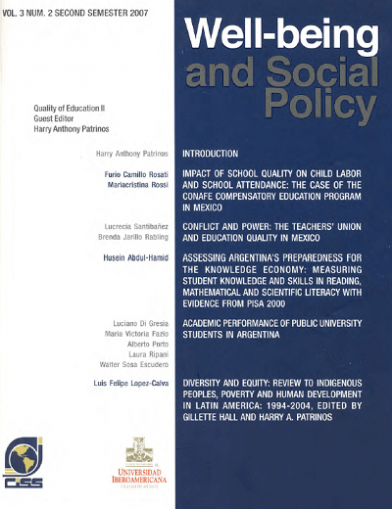
|
|
|
|

|
|
"La Nocturna": study of educational choice in Colombia
This study uses data from Colombia’s 2003 Encuesta de Calidad de Vida to examine how well do electricity strata (proxy for socioeconomic status) explain the choice decision for type of institution and session attended. In the model of choice by type – private vs. public universities – I find that as the electricity strata increases, the marginal probability of enrolling in a public university...
|

|
|
|
|

|
|
Book review. Improving the quality of education in Mexico: Positions and proposals, edited by Francisco Miranda, Harry Patrinos y Ángel López
This book gathers analyses performed by several authors on policies considered appropriate by the World Bank to enhance the quality of basic education provided in Mexico, in particular, education received by majority sectors in our society (World Bank: 2005).
|

|
|
|
|

|
|
Quality of education in Argentina: determinants and distribution using PISA 2000 test scores
In this paper we study the determinants and distribution of learning outcomes in Argentina I measured by PISA 2000 reading and math test scores. To do that, we estimate education production functions at the mean of the distribution using survey regressions and at different parts of the score 's distribution with quantile regressions. In terms of educational policy aimed at improving learning...
|

|
|
|
|

|
|
Institutional effects as determinants of leaning outcomes: exploring state variations in Mexico
We use the PISA 2003 student-level achievement database for Mexico to estimate state education production functions. Student characteristics, family background, home inputs, resources and institutions are controlled for. We take advantage of the state-level variation and representative sample to analyze the impact of institutional factors such as state accountability systems and the role of...
|

|
|
|
|

|
|
Where did you go to school? Private-public differences in schooling trajectories and their role of earnings
The private provision of educational services has been representing an increasing fraction of the Peruvian schooling system, especially in recent last decades. While there have been many claims about the differences in quality between private and public schools, there is no complete assessment of the different impacts of these two type of providers on the labor markets. This paper is an attempt...
|
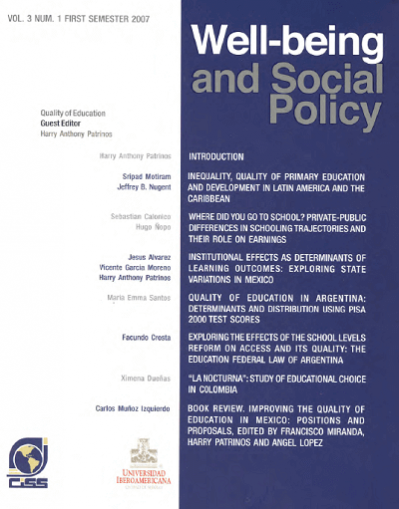
|
|
|
|

|
|
Inequality, quality of primary education and development in Latina America and the Caribbean
This paper draws on a political economy model to hypothesize that the quality of education is likely to be lowered by both economic and political inequalities. In particular, we utilize a panel data set across countries and over time to test the applicability of the hypothesis to quality of education indicators at the primary level. Among the four specific indicators of primary education assigned...
|
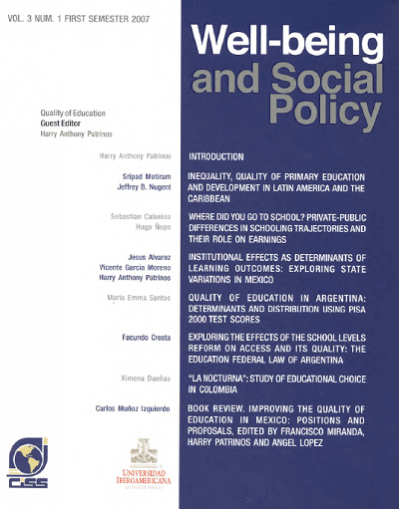
|
|
|
|

|
|
Introduction (about the international conference on "The quality of education in Latin America and the Caribbean")
The Inter-American Conference on Social Security (CISS) and Universidad Iberoamericana (UIA) co-hosted an international conference on "The Quality of Education in Latin America and the Caribbean" in February 2007. The main obj ective of the conference was to examine quality of education in the region, the determinants of learning, policy and program evaluation, and the impact of quality of...
|

|
|
|
|

|
|
Review of International migration, remitances, and the brain drain, edited by Çaglar Özden y Maurice Schiff
As the volume title suggests, three of the studies deal with the effects of remittances on incomes and measures of well-being, four address various aspects of highly skilled migration, while the remaining paper examines the determinants of migration from rural Mexico to the US. Each of these is certainly topical: the rise in reported global remittance flows has been a major spur to the recent...
|

|
|
|
|

|
|
The effects of migration on sending countries: a comparison of Mexico and Turkey
International migrants are persons who cross national borders and remain outside their countries of birth or citizenship for 12 months or more, regardless of the reason for being abroad or legal status while abroad. According to UN estimates, the number of international migrants was 191 million in 2005, and half were in the labor force of the destination country. International labor migration...
|

|
|
|
|

|
|
Workers' remittances and currency crises
We seek to further understand the factors that determine per emigrant remittances using data from 23 Latin American and Caribbean countries over the 1980-2003 period. We find that emigrants avoid remitting when the exchange rate is under pressure. This finding is consistent with the notion that remitters strive to reduce their exposure to exchange rate losses by taking into account the expected...
|
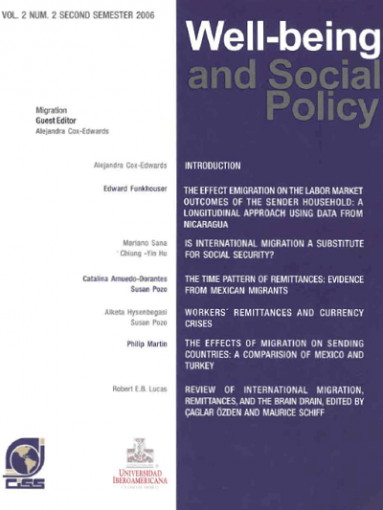
|
|
|
|

|
|
La seguridad social austriaca y su contraste con el sistema mexicano
En el presente trabajo se plantea el análisis jurídico materialista de dos sistemas de seguridad social: el mexicano y el austriaco, cuyo punto medular de comparación jurídica descansa en el análisis de los diversos componentes de cada estudio jurídico comparativo (Zárate, Martínez García y Ríos Ruíz 1997), como son: su origen y desarrollo histórico, su naturaleza jurídica, organización...
|

|
|
|
|

|
|
La práctica médica en el contexto de la economía sanitaria. Falsas premisas y verdaderos problemas
En los últimos 30 años, la ciencia médica ha mostrado un significativo desarrollo mediado por la acelerada innovación tecnológica, condición que trajo aparejada a su vez profundos cambios en los esquemas habituales de diagnóstico y tratamiento, así como un incremento significativo en el costo de la atención médica. Tanto en la introducción de nuevas prácticas, fármacos y equipos sofisticados, es...
|

|
|
|
|

|
|
Panorama laboral 2003
Intervención de Juan Somavía, Director General de la Oficina Internacional del Trabajo. Santiago de Chile, 7 de enero de 2004.
Intervention of Juan Somavía, Director General of the International Labor Office. Santiago de Chile, January 7, 2004
|

|
|
|
|

|
|
Indice de desarrollo de la seguridad social. Informe final
Este trabajo elabora un índice de desarrollo de la seguridad social combinando factores demográficos, del mercado de trabajo y la capacidad de financiar el gasto público social, como factores fundamentales para su diseño. Expande el indicador de dependencia demográfica tradicional que relaciona al número de individuos en edades dependientes con el número en edades activas, mediante una variante...
|

|
|
|
|

|
|
Tercera Conferencia Interamericana de Seguridad Social, Buenos Aires, 1951
Discurso del Presidente de la República Argentina, Gral. Juan Perón, para declarar inaugurada la III Reunión de la Conferencia Interamericana de Seguridad Social.
His Excellency, the President of the Republic of Argentina, Gral. Juan Perón inaugurates de III Meeting of the Social Security Inter.-American Conference
|

|
|
|
|

|
|
Una experiencia de protección social en el campo mexicano
Los antecedentes y orígenes del Programa IMSS-Solidaridad, se remontan a junio de 1974 cuando, con base en la facultad conferida al Instituto Mexicano del Seguro Social por la nueva ley de 1973, se iniciaron los servicios de solidaridad en favor de la población más desprotegida.
Por ello, en 1979, el Gobierno Federal hizo la petición ante el H. Consejo Técnico para que el IMSS proporcionara...
|
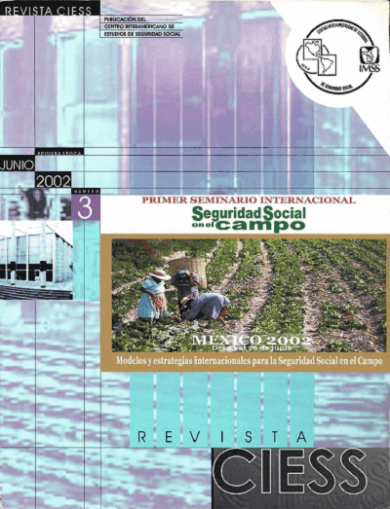
|
|
|
|

|
|
Anualidades contingentes. Proyección del ahorro capitalizado y renta vitalicia en un modelo previsional de capitalización
Este trabajo expone los instrumentos de análisis necesarios para evaluar:
1. El capital necesario para obtener una renta vitalicia con anualidades iguales al último salario del afiliado a un sistema de capitalización.
2. El monto del aporte capitalizado logrado al culminar la vida activa del afiliado a un sistema previsional de capitalización.
3. Opciones para calcular el valor de las...
|
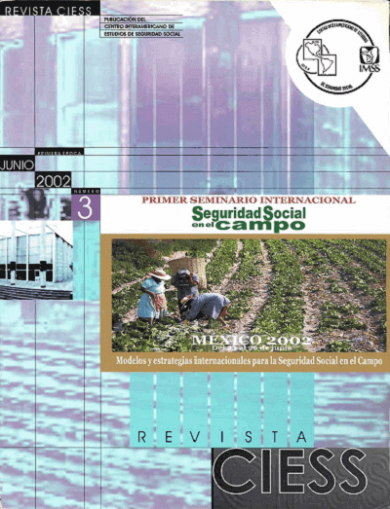
|
|
|
|

|
|
El manejo de las relaciones publicas y los medios de comunicación en los hospitales
El artículo explica cómo las relaciones públicas se insertan en el concepto más amplio de comunicación, y cómo su naturaleza y universo tienen que ver con la influencia del entorno en la vida de los hospitales. Relaciona la evolución de las relaciones públicas con el incremento de la conciencia de las personas sobre sus derechos a la protección de su salud y la acción trascendente de los medios...
|

|
|
|
|

|
|
Salud demorada es justicia negada
En este texto se presenta el tema fundamental sobre, “Políticas de la salud y equidad”, como un asunto que se apoya fundamentalmente en la hipótesis de que pueda progresarse si nuestros pueblos logran en alguna medida la justicia social mediante una adecuada política sanitaria. La negación de esa justicia es resultado de la demora en lograr la salud para un gran número de nuestros habitantes....
|
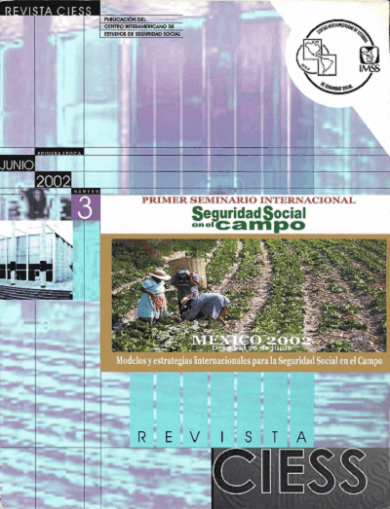
|
|
|
|
|